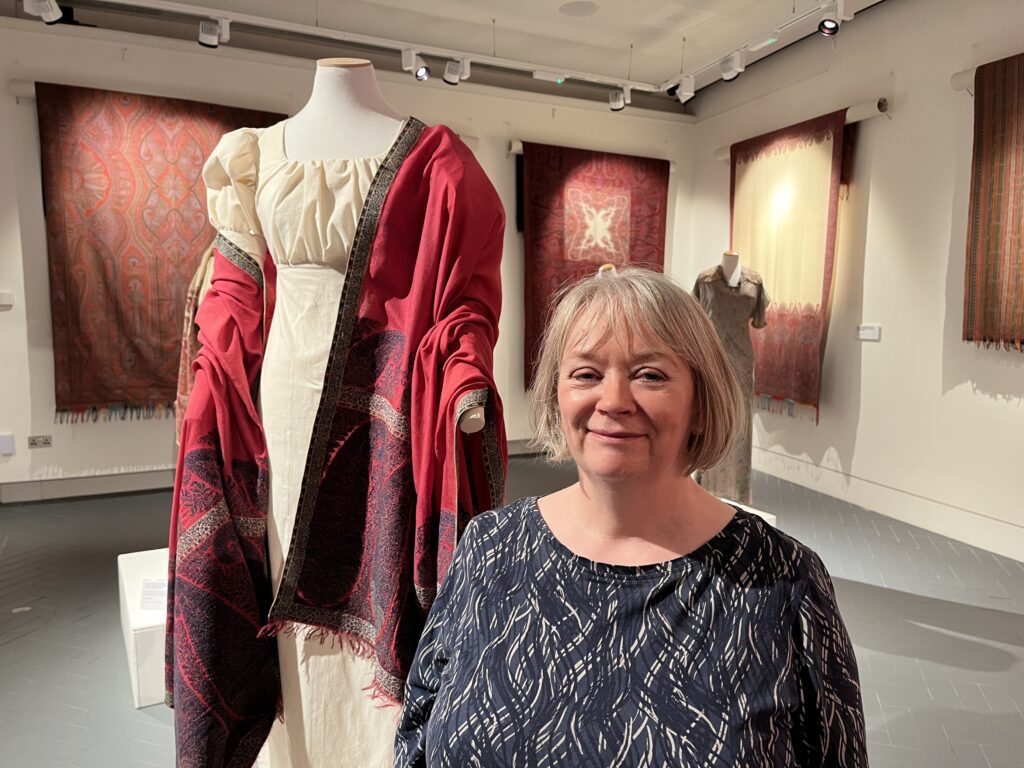Paisley shawls feature in Great Tapestry of Scotland
25/03/2024
Edinburgh was weaving what became known as Paisley shawls in the 1700s more than 40 years before the Renfrewshire town they were named after, a new exhibition will show.

Hosted by UKFT Education Partner Heriot-Watt University and The Great Tapestry of Scotland in Galashiels, the exhibition will reveal that Edinburgh weavers were the first in Britain to create replicas of the Kashmir shawls brought back from India, the first recorded being in 1767.
It wasn’t until 1808 that Paisley’s weaving industry started making the shawls, and later gave the garment its iconic name.
The exhibition, called A Passion for Paisley, will feature a selection from the range of more than 100 shawls and shawl fragments that forms part of the University’s textile collection, housed in the Scottish Borders Campus in Galashiels.

Helen Taylor, Archivist at Heriot-Watt University (pictured above), said: “Paisley design has stayed a very iconic motif and has remained a fixture even as fashions have changed. Our collection in the Borders is a very good one and was really developed for teaching and research. You can’t recreate the weaving, because the looms don’t exist anymore. But if you’re looking for design inspiration, Paisley shawls are a great example of East-West influence.”
Paisley shawls are richly patterned and often feature a distinctive Persian-style teardrop motif. This is inspired by the Babylonian Tree of Life, a magical tree from Mesopotamian mythology that grew in the centre of paradise.
Other motifs include floral and tendril designs, a striped zebra design and an oblong motif known as a ‘temple door’ design. Red was a recurring colour in Paisley shawls, alongside blues, greens, yellows and other colours, all created from natural plant dyes. Paisley shawls were hugely popular in the 18th and 19th centuries. Empress Josephine, Napoleon’s first wife, was known to own about 400 of the woollen shawls.
“When the British empire was expanding, people started bringing back Kashmir shawls as gifts,” Ms Taylor explained. “They were very expensive and were actually woven in cashmere. Weavers in Edinburgh started making reproduction shawls, and the first record of a reproduction Kashmir shawl being woven was in Edinburgh in 1767.”
Edinburgh in the 1700s already had a damask industry – when designs are woven into fabric rather than printed onto it – and it was these weavers who started making the reproduction Kashmir shawls. But when fashions evolved and the shawls got bigger, the Edinburgh weavers started outsourcing to Paisley, where weaving skills and technology were advancing and amongst the best in the world.
“In Edinburgh, shawl weaving was more of a cottage industry, with small looms being used around the city’s Old Town and shawls being woven in sections and sewn together,” Ms Taylor said. “In Paisley, they started using Jacquard looms, which used punch cards and allowed more complex design to be woven more easily.”
Most of Heriot-Watt’s Paisley shawls were collected by a ceramics curator called Janet Paterson who collected Paisley shawls in the 1940s and 50s. The collection was given to the University by her son, Alan, along with his tartan collection.
A Passion for Paisley runs from 26 March to 12 July 2024 at The Great Tapestry of Scotland, 14-20 High St, Galashiels TD1 1SD. There is an entrance fee of £5.
The event includes a talk at 12.30pm on 26 March about the forgotten legacy of Edinburgh’s vibrant weaving industry. Tickets for this event can be booked here: A Passion for Paisley Opening Lecture.
Heriot-Watt School of Textiles and Design dates back to 1883, when classes in weaving, dyeing and chemistry were introduced to train workers for the local textiles industry.
The School is a centre of excellence in design, with Honorary Graduates including British fashion icon Dame Vivienne Westwood. It is based on Heriot-Watt’s Scottish Borders Campus, which is built around a historic mill in Galashiels, at the heart of Scotland’s luxury textile industry.
The Great Tapestry of Scotland visitor centre was purpose-built to house The Great Tapestry of Scotland, one of the world’s largest community arts projects. The Tapestry was hand-stitched by a team of 1,000 stitchers from across Scotland and charts 420 million years of Scotland’s history, heritage, innovations and culture through 160 panels.
Heriot-Watt is a UKFT Education Partner. Are you interested in joining UKFT? Find out more about our membership:
